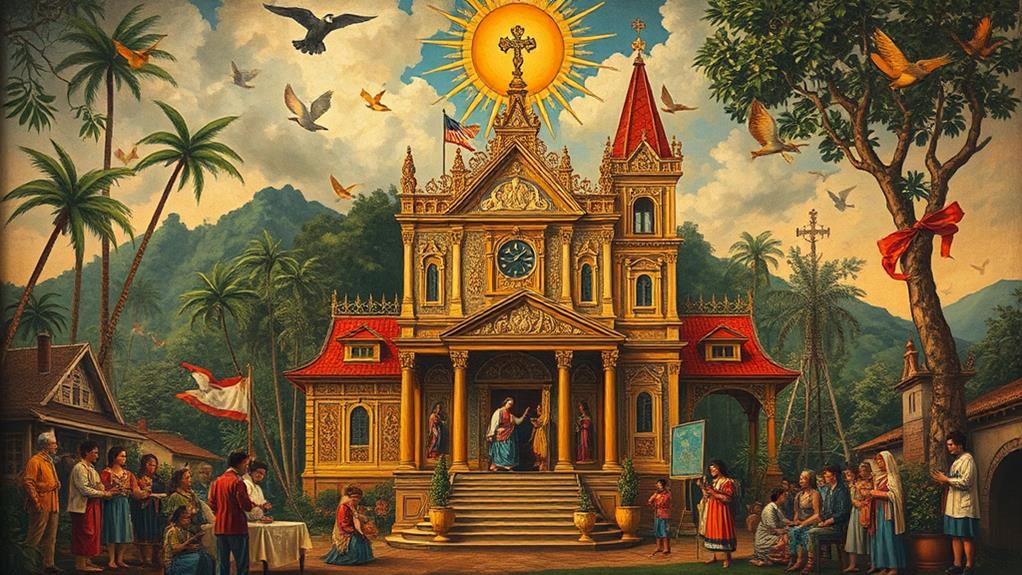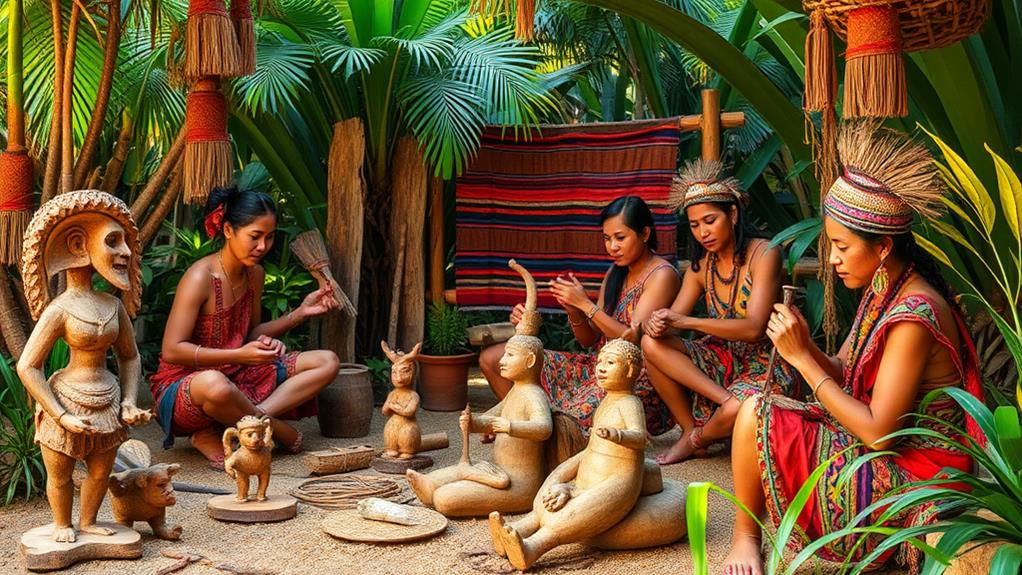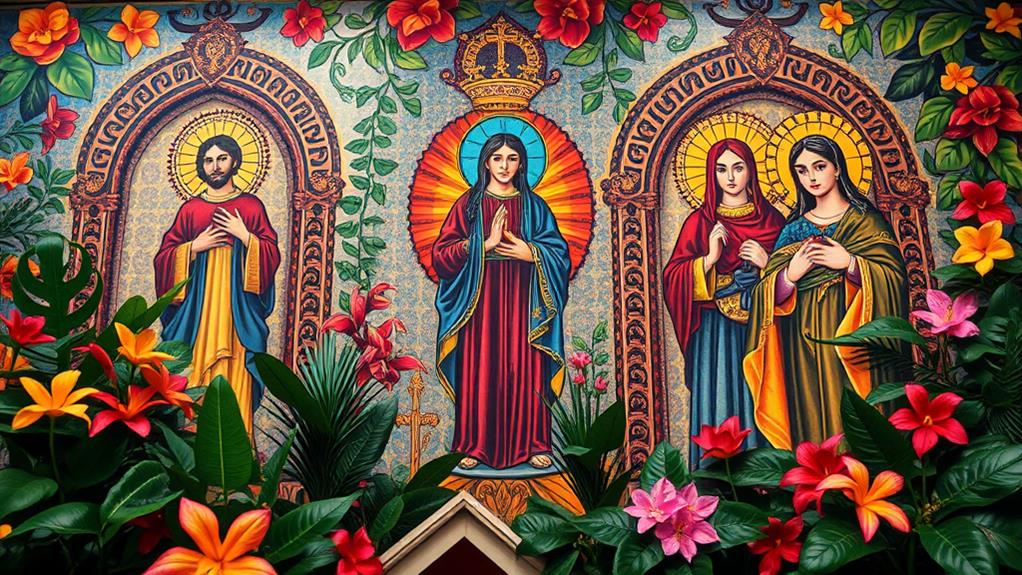Religion plays a significant role in shaping Filipino art and literature. This is evident in the blending of Catholic traditions with indigenous beliefs, resulting in a unique cultural identity.
Catholic imagery is prominent in artworks like retablos, which are traditional Filipino devotional paintings that adorn altar pieces. These artworks often feature vivid depictions of saints, angels, and biblical scenes, reflecting the country's strong Catholic heritage.
Traditional narratives honor ancestral spirits, such as the "anito" in Filipino folklore, which are believed to inhabit natural elements like trees, rivers, and mountains. These spirits are often depicted in stories, poems, and songs, highlighting the importance of respecting and preserving the natural environment.
Syncretism shapes community identity, as seen in lively festivals that merge spiritual and cultural expressions. For example, the Fiesta de Santo Niño celebrates the feast of the Child Jesus, blending Catholic and indigenous traditions through music, dance, and vibrant costumes.
Contemporary artists tackle social issues, echoing past traditions while inspiring new dialogues. They use their art to raise awareness about pressing concerns, such as environmental degradation, social justice, and cultural preservation.
Literature reflects this dynamic, intertwining spiritual themes with cultural stories.
Novels like "Noli Me Tangere" by José Rizal preserve the richness of Filipino culture for future generations, while exploring the complexities of the country's historical and social landscape.
Historical Overview of Religion in the Philippines

Religion in the Philippines: A Blend of Indigenous and Colonial Influences
Before the arrival of Spanish colonizers, Filipinos worshipped a pantheon of gods, with Bathala as the supreme deity. Shamans conducted rituals to guide the people. The introduction of Islam in 1350 and Christianity in 1565 significantly changed the spiritual landscape.
Catholicism became the dominant faith, blending with folk traditions and animism, especially in rural areas where indigenous practices persisted. During the colonial period, Spanish efforts to Christianize the population led to a unique fusion of Catholicism and local beliefs.
This transformation influenced not only faith but also Filipino religious art, which began to reflect a blend of European styles and indigenous motifs.
The Philippine Revolution in 1898 and subsequent American rule allowed for the emergence of various sects, including the Aglipayans, which challenged the Catholic Church's supremacy.
Today, about 80% of Filipinos identify as Catholic, signifying the enduring impact of this faith on their culture and identity. This has set the stage for rich artistic expressions that continue to evolve.
Influence of Catholicism on Art
Catholicism's Enduring Influence on Filipino Art
The Catholic Church has profoundly impacted Filipino art, resulting in a unique fusion of faith and culture. Filipino art is characterized by a blend of Christian themes and local identity.
Iconic Religious Artworks
Filipino artists have created masterful retablos and altarpieces depicting Biblical scenes, showcasing their mastery of artistic techniques introduced by Spanish friars. These artworks demonstrate exceptional skill in woodcarving, painting, and sculpture.
Local Materials and Motifs
Filipino artists have skillfully incorporated indigenous materials and cultural elements into European artistic standards. For example, they used native woods, such as narra and kamagong, to create intricate carvings and ornate decorations.
This blend of influences has resulted in a distinctive style that reflects both Catholic and local traditions.
Celebratory Displays
Major religious celebrations, like Christmas and Holy Week, feature elaborate artistic displays that reinforce the importance of Catholicism in community life and identity. These displays often include colorful processions, vibrant costumes, and ornate floats adorned with flowers and lights.
Through these artistic expressions, it's clear that Catholicism hasn't only shaped the visual arts but also fostered a sense of belonging and continuity within Filipino culture. This rich tapestry of faith and creativity continues to influence contemporary Filipino art.
Indigenous Beliefs and Artistic Expressions

Indigenous Beliefs Shape Filipino Art
Before Spanish colonization, Filipinos worshipped a pantheon of gods and spirits, with Bathala as the supreme deity. This rich spiritual landscape influenced artistic expressions, particularly in traditional arts like sculpture and ritual performance. Many indigenous artworks depict rituals involving sacrifices to both benevolent and malevolent spirits, directly reflecting the community's beliefs.
Shamans and Priests: Spiritual Intermediaries
Shamans and priests, often revered as spiritual intermediaries, are central figures in these narratives. Their supernatural powers and roles are frequently represented in art, emphasizing the importance of the spiritual realm in daily life. Ancestral spirits are depicted through wood and metal images, showcasing the significance of lineage and ancestry in indigenous cultures.
Syncretism in Contemporary Filipino Art
As you explore contemporary Filipino art and literature, you'll notice the blending of indigenous beliefs with later introduced religions, particularly Catholicism. Traditional motifs and symbols intermingle, creating a unique artistic dialogue that honors both the past and present.
This blending enriches the artistic landscape, ensuring that indigenous heritage remains vibrant and influential.
Contemporary Religious Dynamics
Contemporary Filipino Society and Shifting Religious Dynamics
As Filipino society evolves, religious dynamics are changing dramatically. Approximately 80% of the population still identifies as Catholic, but various small sects and fundamentalist groups are emerging, challenging traditional Church authority. This shift reflects a broader struggle for identity and community engagement among Filipinos.
Decline of the Aglipayan Church
Once a strong alternative, the Aglipayan Church's influence has dwindled to about 5%, showcasing the shifting landscape of belief systems. This decline highlights the changing religious preferences of Filipinos.
Grassroots Movements and Social Justice
Initiatives focusing on social justice are causing friction between the Catholic Church and government, highlighting the disconnect between traditional religious practices and contemporary societal issues.
For example, some Catholic leaders oppose the government's reproductive health policy, while others support it.
Cultural Education and Evolving Expressions of Faith
Programs from organizations like the Asia Society Museum provide a platform for evolving expressions of faith by fostering deeper engagement with the arts and contemporary religious themes.
These programs encourage Filipinos to explore and express their faith in new and creative ways.
The Influence of Christian Beliefs on Filipino Arts and Literature
These contemporary shifts illustrate the strong influence of diverse Christian beliefs on Filipino arts and literature, showcasing how religion continues to shape identity and creativity in this dynamic society.
Syncretism in Filipino Culture

Syncretism Shapes Filipino Culture
The blending of beliefs has a profound impact on Filipino culture, particularly the merge of indigenous practices with foreign religions, such as Catholicism. This blend is evident in visual art, where traditional Filipino motifs coexist with Catholic iconography. For example, the Santo Niño image is a powerful symbol that intertwines local customs with religious significance.
Festivals Reflect Syncretic Spirit
Festivals showcase the unique blend of Catholic feast days and local traditions, highlighting the rich cultural expression that honors both heritage and faith.
Each fiesta celebrates the dynamic fusion of diverse influences while retaining the core Filipino identity. This distinct blend stands out in Southeast Asia, demonstrating the ability of Filipino culture to adapt and evolve.
Literature Mirrors Syncretism
The works of José Rizal exemplify syncretism in literature, where colonial and indigenous narratives collide to shed light on social injustices.
Rizal's writings weave local folklore and beliefs into a broader critique of society, emphasizing the enduring impact of syncretism on Filipino identity. By embracing these blended beliefs, one can witness the richness, resilience, and adaptability of Filipino culture through centuries of change.
Artistic Reflections of Spirituality
The syncretic nature of Filipino culture profoundly influences artistic expressions of spirituality, where diverse beliefs converge and manifest in various forms.
Traditional Weaving showcases the fusion of religious themes and cultural identity. Each ethnic group's textiles feature intricate patterns that symbolize their spiritual beliefs. For example, the T'boli people of Mindanao weave dream patterns that reflect their spiritual connection with nature. These patterns are woven into every piece, revealing how their cultural narratives are intertwined with their spiritual beliefs.
Carving Traditions also reflect the convergence of spiritual and cultural identities. Wood and ivory carvings often depict indigenous figures and ancestral symbols, serving not just as art but as vital representations for spiritual rituals. Anito figures, for instance, are carved to honor ancestral spirits and are used in rituals to ensure good harvests and protection.
Contemporary Expressions of spirituality in Filipino art continue to address social issues while revitalizing traditional religious art forms. Today's Filipino artists engage with spiritual themes, bridging the past with the present. Jeffrey Gibson's mixed-media artworks, for example, combine traditional Filipino motifs with contemporary materials, exploring the intersection of spirituality and identity.
Folk literature also illustrates how spiritual narratives and cultural stories intertwine, shaping Filipino identity. This rich tapestry of artistic reflections honors tradition and invites dialogue, allowing both artists and audiences to explore the evolving landscape of spirituality in Filipino art.
These artistic expressions encourage reflection on one's beliefs and cultural roots.
Questions and Answers
Why Is Religion Important to Filipinos?
Religion plays a vital role in shaping the cultural identity of Filipinos. This is because it's deeply rooted in the country's history and is a significant part of daily life.
Religion provides a sense of community and belonging, where shared values and beliefs bring people together, strengthening family and social bonds.
Moral values derived from religious teachings guide daily actions and decisions. For example, the Catholic Church's emphasis on compassion and kindness encourages Filipinos to be charitable and help those in need.
These values foster a sense of responsibility and promote social harmony across the country.
How Has Religion Played a Role in Art?
Religion has significantly influenced art throughout history. By providing spiritual symbolism, artists can convey moral teachings and inspire viewers. For example, Michelangelo's Sistine Chapel ceiling paintings depict scenes from the Book of Genesis, illustrating the story of creation and God's relationship with humans.
Narrative focus is a key element in religious art, as it allows artists to weave together stories that reflect faith and identity. The frescoes in the Brancacci Chapel, created by Masaccio and Masolino, showcase the life of Saint Peter, demonstrating the artist's ability to convey spiritual messages through visual storytelling.
Rituals and beliefs serve as a source of artistic inspiration, transforming everyday experiences into profound works. The intricate designs and calligraphy in Islamic art, for instance, reflect the importance of geometric patterns and Arabic script in Muslim culture.
The connection between spirituality and creativity enriches both the artist's journey and the audience's understanding. By exploring the intersection of faith and art, artists can create works that resonate deeply with communities and inspire meaningful reflection.
What Is the Role of Religion in Literature?
Religion significantly influences literature, shaping stories that explore spiritual themes and cultural identity.
Writers often use narrative symbolism to convey moral lessons, reflecting their beliefs and societal values. For example, in John Bunyan's The Pilgrim's Progress, the character of Christian represents a Christian's journey towards spiritual enlightenment, symbolizing the struggles and triumphs of faith.
By examining these texts, readers can appreciate the interplay between faith and storytelling, revealing deeper insights into the human experience.
Religion not only influences characters and plots but also the very essence of a community's identity, as seen in works like James Joyce's Ulysses, which explores the Catholic roots of Irish identity.
What Effect Does Religion Have on Art Language and Literature?
Religion influences art, language, and literature by infusing them with cultural identity and moral values.
Artists and writers often draw on spiritual inspiration to create symbolic expressions that resonate with personal and collective experiences. For instance, Michelangelo's famous painting, the Sistine Chapel ceiling, is a masterpiece of Renaissance art that showcases his Christian faith. The vivid depictions of biblical scenes and figures reflect the artist's spiritual beliefs, making the artwork a testament to the intersection of faith and creativity.
Religious themes in art, language, and literature reflect societal issues, allowing for a deeper understanding of human existence.
Through a narrative focus, authors and artists explore complex social issues, such as morality, justice, and forgiveness, using religious themes as a backdrop. For example, John Steinbeck's novel, "The Grapes of Wrath," is set during the Great Depression and explores the struggles of the working class through a Christian lens. The characters' experiences and struggles are mirrored in biblical stories, highlighting the universal themes of hope, perseverance, and redemption.
The dialogue between faith and creativity deepens our appreciation for diverse artistic expressions.
By examining the relationship between religion and art, language, and literature, we gain a richer understanding of the cultural and historical contexts in which they were created.
This interdisciplinary approach reveals the ways in which artists and writers use religious themes to convey complex emotions, ideas, and values, ultimately enriching our appreciation for the diversity of human creative expression.